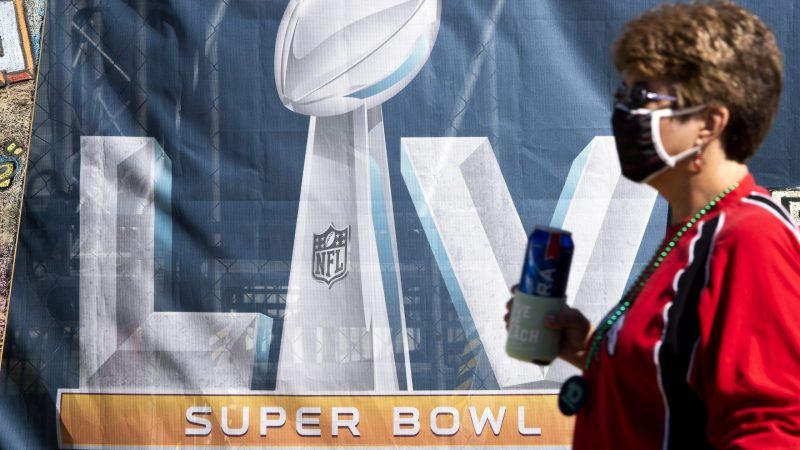The NFL Challenged Conventional COVID-19 Wisdom and Kept Playing
In staring down the virus's blitz, the NFL showed that it is possible to balance caution and continuity.

The Seattle Seahawks won't be playing in the Super Bowl this weekend, but the team accomplished something this year that no other National Football League (NFL) franchise did. Not a single Seahawks player or coach tested positive for COVID-19.
What is perhaps even more remarkable than Seattle's perfect season is what that means the rest of the league endured during the past few months. When the NFL season comes to an end on Sunday night, the league will have survived potentially destabilizing outbreaks within 31 of its 32 locker rooms—at a time when cases and deaths were spiking across the United States. But the NFL reached its championship game without having to cancel a single one of the 269 scheduled games in the regular season and playoffs—and, most importantly, without any deaths due to the virus.
The NFL accomplished that feat with the help of nearly 1 million COVID-19 tests conducted since August 1, strict protocols for players and staff, a robust contact-tracing system that intercepted potential outbreaks, and (if we're being totally honest) probably a bit of good luck too. In staring down the virus's blitz, the NFL showed that it is possible to balance caution and continuity—that even before a vaccine is widely distributed it is possible to slow COVID-19's spread without shutting everything down.
Along the way, the league also challenged a core tenet of the public health community's understanding of how COVID-19 spreads.
As The Wall Street Journal reported on Friday, a mid-October outbreak in the Tennessee Titans' locker room proved stubbornly difficult to contain under existing protocols that assumed someone should be considered to have been "exposed" to the virus only if they'd been within six feet of an infected person for more than 15 minutes. But most of the 21 people within the Titans organization who eventually tested positive had no direct interactions with one another for that length of time.
Thanks to the resources the NFL brought to bear against the disease—ESPN reports that COVID-19 countermeasures cost the league more than $100 million—the league's medical officials were eventually able to conclude that the six-feet, 15-minute guidelines from the Centers for Disease Control and Prevention (CDC) were unreliable.
In response, the NFL updated its protocols with more nuance. "A masked encounter outdoors could then be treated differently than an unmasked shared car ride, for instance," write WSJ reporters Andrew Beaton and Louise Radnofsky. "The NFL told teams to take meetings virtual, avoid indoor gatherings, even if they were distanced and quit eating together."
In short, the league discovered that COVID-19 was even more spreadable than the scientific consensus believed in mid-October. It adapted, took necessary countermeasures, and pressed forward.
It's fair to point out, of course, that even the wealthiest Americans and most successful businesses would have a difficult time replicating the NFL's intensive testing-and-tracing regime. Still, what the league uncovered offers a potential guide for the rest of us as we navigate what are hopefully the final months of the pandemic. After a year of sometimes contradictory, often confusing, and frequently counterproductive instructions and orders from officials, the NFL offers an example not only of how to keep the games going during unusual circumstances but of the mental fortitude necessary to combat an evolving health threat.
It didn't always work perfectly. The Denver Broncos took the field in late November without a quarterback—a kind of important position in football—after all three of theirs tested positive in the days before a game. They lost by 28 after having a backup wide receiver who hadn't played QB since high school fill in under center. A Thanksgiving game between the Pittsburgh Steelers and Baltimore Ravens was postponed from Thursday to Sunday, then to Tuesday, and eventually played on Wednesday afternoon after a COVID-19 outbreak blew through the Ravens' locker room. Players in isolation were forced to find interesting new ways to practice, like the Cleveland Browns' lineman who prepared for a playoff game by practicing with his girlfriend in an apartment building parking lot.
A total of 15 games were postponed or rescheduled during the regular season, and 724 positive tests sidelined players and coaches at various points. Even in places where fans were allowed to attend games, restrictions on stadium capacity made it seem like every team was suffering through a terrible season. The lead-up to this week's Super Bowl hasn't included the usual pomp.
It wasn't a perfect season, but it worked—and it worked better than many public health experts expected.
Eric Rubenstein, an assistant professor of epidemiology at the Boston University School of Public Health, told ESPN this week that most professionals in his field were "suspicious" of the NFL's plans to conduct what was essentially a normal football season—no "bubbles" for players and coaches, teams playing in their home stadiums, and traveling back-and-forth across the country for games.
"But in the end," Rubenstein said, "the lack of real serious morbidity and sickness is evidence that what they did worked for the people they cared about."
